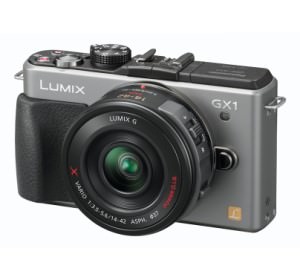-
 When Panasonic released the Lumix DMC-GF1 during 2009, it became a favorite of many digital photography enthusiasts as a secondary camera to their DSLRs. These photographers like the GF1’s rangefinder design, many external controls and its array of Micro Four Thirds lenses. Now, with the March 2012 release of the new Lumix DMC-GX1, Panasonic is giving enthusiasts another reason to consider this interchangeable lens system camera as a worthy descendant of the GF1.
When Panasonic released the Lumix DMC-GF1 during 2009, it became a favorite of many digital photography enthusiasts as a secondary camera to their DSLRs. These photographers like the GF1’s rangefinder design, many external controls and its array of Micro Four Thirds lenses. Now, with the March 2012 release of the new Lumix DMC-GX1, Panasonic is giving enthusiasts another reason to consider this interchangeable lens system camera as a worthy descendant of the GF1.There were 33 real customer reviews of the Lumix GX1 all giving it 4-5 star rating if you would like to read these reviews you can do so here.
-
With the GF1 being such a winner, Panasonic designed the new GX1 to look very similar. The retro style is less evident, but there is just enough of it to appeal to the enthusiasts who liked the GF1. The GX1 has a more prominent handgrip and maintains a comprehensive selection of controls and buttons across the top of the camera.
-
Enthusiasts will gravitate towards this configuration of controls on the top of the GX1’s aluminum body. There, they’ll find a built-in, pop-up flash; stereo speakers; flash hotshoe; shooting mode dial with integrated on/off switch; dedicated button for the Intelligent Auto mode, which appears as a blue light when activated; tactile shutter button; and a one-touch movie button.
-
Despite all these design extras, Panasonic was still able to keep the GX compact, with dimensions of 4.58 x 2.67 x 1.55” (116.3 x 67.8 x 39.4mm) and a total weight of 13.16 oz. (373g), with an SD card, battery and 14–42mm kit lens. This new Panasonic digital camera is very similar in size to top-of-the-line compacts, but, of course, they don’t have interchangeable lenses.
-
Lenses for the Lumix DMC-GX1 are certainly a big part of the appeal of this camera. Panasonic reduced their size, especially the 14–42mm kit lens. For a camera that is comparable with the features and quality of some DSLRs, it’s rather amazing that the GX1 can be carried in a large pocket (such as a coat) and many smaller bags and purses.
-
The new Lumix DMC-GX1 may have the same 16-megapixel Live MOS sensor as the DMC-G3, but Panasonic has “refurbished” its Venus image processor, so the new GX1 offers an ISO range to 12,800. Enthusiasts will have the kind of low-light versatility they expect as Micro Four Thirds technology continues to improve.
-
The 14–42mm power-zoom kit lens includes image stabilization (IS) technology that is utilized in one of three modes, controlled from the menu system. Blurring caused by camera shake is minimized, since Mode 1 is activated throughout the shooting process. Mode 2 takes effect when the shutter button is pressed. Mode 3 specifically addresses any vertical movement. As with all IS systems, the one in the Panasonic Lumix DMC-GX1 makes it possible to shoot at slower shutter speeds in low light handheld and still record clear, crisp images.
-
The GX1 is also a good choice for compact camera users who are ready to graduate to an interchangeable lens system camera with more DSLR capabilities. The learning curve is made easier and quicker, however, with the GX1’s Intelligent Auto (iA) mode. As with point-and-shoot cameras, the iA in the GX1 reads any scene or subject according to various presets, and then selects the correct exposure, image stabilization and auto-focus parameters.
-
The Panasonic GX1 shoots 1080i Full HD and 720p HD video at 60fps. The recording format for both is AVCHD (MPEG-4/H.264). The camera also records MP4 movies at 1920x1080, 1280x720 and 640x480 pixels, all at 30fps. The camera also includes an HDMI port, so it can be connected to a HD TV (optional HDMI mini-cable required). Beginners will have it just as easy shooting video, since Intelligent Auto mode works identically to taking still photos.
-
Digital photography enthusiasts demand a relatively high image quality in a new camera; and the Panasonic Lumix DMC-GX1 delivers and may exceed the expectations of many. Third-party tests reveal excellent quality, with a rather wide ISO range, 100–800, capable of generating noise-free photos. In fact, noise isn’t actually an issue until approaching ISO 1,600, which is quite an achievement for a Micro Four Thirds camera. This is good news for the enthusiasts that liked the older GF1 so much and definitely the beginners, who will be thrilled to see much sharper and color-rich images than their compacts were capable of producing.
-
The Panasonic Lumix DMC-GX1 Digital Camera is available from B&H Photo Video, as either body only for $699.00, or with the G VARIO 14–42mm kit lens for $779.00. Find all ordering information at http://www.bhphotovideo.com/c/search?Ntt=panasonic+lumix+dmc-gx1&N=0&InitialSearch=yes.
People who read this PhotographyTalk.com article also liked:
Photo Copyright ©2011 Panasonic
Your feedback is important to thousands of PhotographyTalk.com fans and us. If this article is helpful, then please click the Like and Re-Tweet buttons at the top left of this article.
